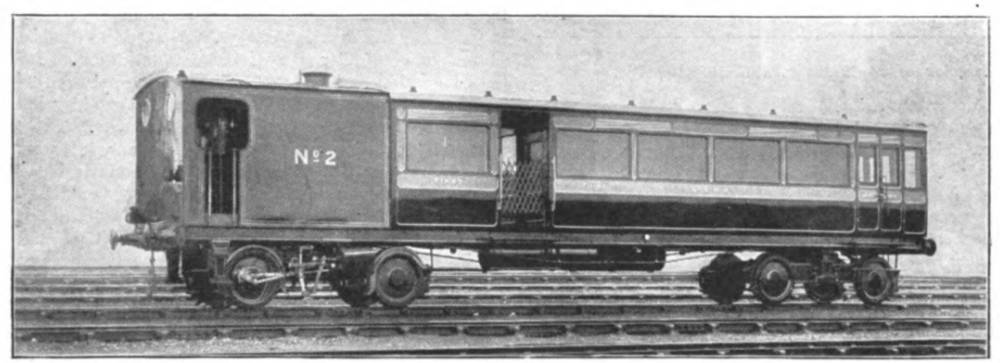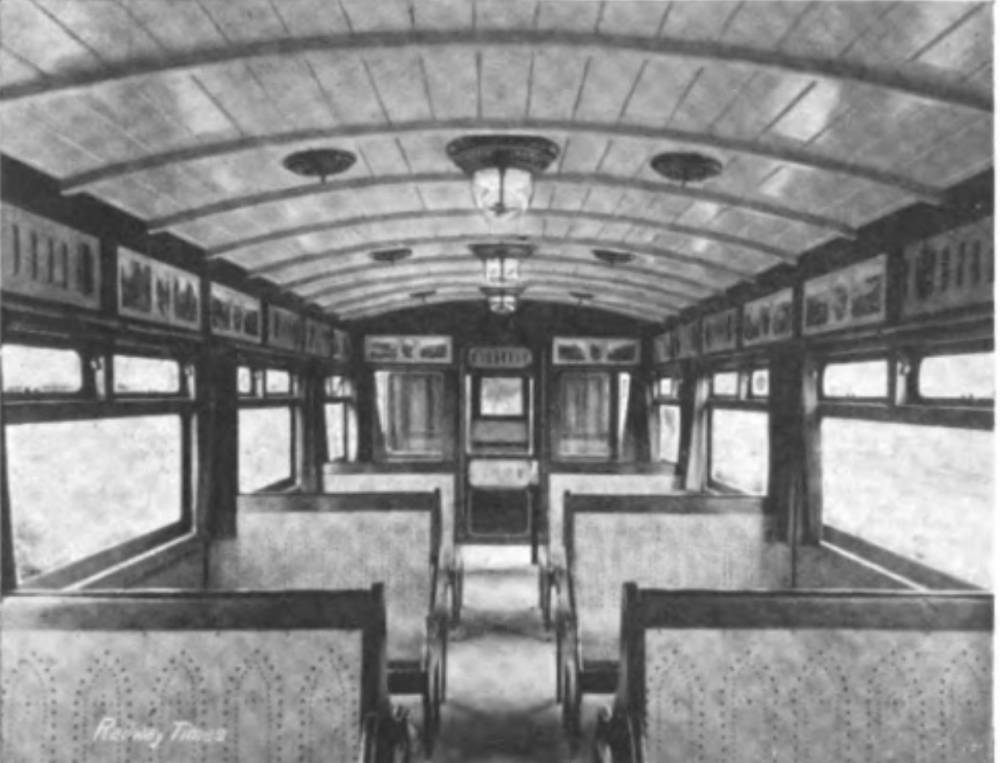
New Steam Motor Car for the Great Northern Railway from the 1905 Railway Times. [Click on image to enlarge it.]
Article from The Railway Times for 4 November 1905
The extensive rail motor services established on the Great Western, North Western, North Eastern, and several other lines have already been described in the pages of THE RAILWAY TIMES, but little has hitherto been heard of the motor cars of the London and South Western Railway. As a matter of fact, the latter company is entitled to the credit of introducing the rail motor to this country. Three years ago the general manager (Sir Charles Owens) decided to experiment with this form of traction, and, consequently, Mr. Dugald Drummond, the chief mechanical engineer, set to work to design a suitable type of vehicle. Mr. Drummond‘s plans were speedily adopted, and in April, 1903, the first steam rail motor car was ready for use. The line selected for the experiment was the railway between Fratton and East Southsea—the joint property of the South Western and Brighton companies. Before the car was put into regular service, the Great Western Railway Company, in June, 1903, requested the loan of the car for experimental purposes on their own line, the result being that they rapilly proceeded to follow up and develop the scheme inaugurated by the South Western Railway. The pioneer car which forms the subject of our first illustration was quickly follovwd by another of the same type, and since the spring of 1903 those two cars have been running continuously on the Fratton and Southsea line. They have fully met the requirements of the district, and have effected a considerable economy in working costs. The distance between the two stations mentioned is 1 1/4 miles, and the cars make thirty-five journeys in each direction daily.

The First British Rail Motor Car. Designed by Mr. D. Drummond.
Last year the London and South Western Company introduced two other rail motor services—one on the Botley and Bishop’s Waltham line, between Eastleigh and Fareham, the other from the Friary Station (Plymouth) to Plymstock and Turnchapel. The former is 3 3/4 miles in length, and the cars run dain thirteen times each way, while over the Friary and Turnchapel route, of about 2 1/2 miles, no fewer than forty-two journeys are daily completed. These three services have been so well patronised that the results have induced the company to provide similar facilities on several other sections of their extensive system. The directors have recently sanctioned the construction of rail motors to run regularly on the following line:—
1. Between Exeter and Honiton.
2. Between Bournemouth and Christchurch.
3. Between Bodmin and 'Wadebridge.
4. Between Fullerton, Hurstbourne, and Whitchurch (near Andover).
5. Between Exeter and Topsham.
An examination of the surface area intersected by the South Western Railway gives the impression that rail motors are equally suitable in many other places, and the time is probably not far distant when they will form a still more important item in the company‘s work. The Bournemouth and Christchurch service will represent a determined attempt to cope with the municipal tramway competition in a large centre of population, and the experiment will, no doubt, be watched with peculiar interest throughout the country. It is intended that the cars shall travel frequently between Bournemouth West and Christchurch, and there will be a stopping-place at Meyrick Road Bridge, with further halts possibly in the future.

Improved Type of Car designed by Mr. Drummond for the L. & S.W. Railway.
Our second illustration shows an improved type of steam rail motor, designed by Mr. Drummond for this and other services. This car embodies a distinct improvement in general outline. The little locomotive which projected from the body of the original car has disappeared from external view, and the tractive power is now completely enclosed. A strong steel underframe rests upon two bogies, one of which contains the boiler and the engine. The cylinders are 9 in. in diameter, with a stroke of14 in., and the wheel diameter is 3ft.

Interior of the South Western Rail Motor Car.
A collapsible door gives admission—on one side to a first-class compartment, comfortably seated to accommodate eight passengers, and on the other to a third-class compartment, in which seats are provided for thirty-two persons. The former compartment is next to that intended for the reception of luggage, and the latter is immediately behind the driver’s cab. A wide passage runs down the centre of the car, and each compartment is enclosed by doors fitted with Ramsey rollers and runners, as well as check plates to prevent rattling. These doors may be opened without the slightest noise when the car is running.
The finishing of the first-class compartment is of polished walnut, with Hungarian ash fascias and figured lincrusta, and the upholstery is of blue cloth. In the third-class compartment there is teak framework, with photo fascias and mahogany doors. The seats are of polished plywood, with mahogany frames, and the floor is covered with corticene. Coloured photochroms of places of interest on the South Western system are exhibited throughout the car on the sight line, and in each compartment there are maps of the company’s system. All the windows have curtains of red crepe hanging from brass rods. In addition to corticene, the floor of the first-class compartment is furnished with a hair mat. The cars are steam-heated in winter on the storage principle, and ventilated by torpedo air extractors and sliding shutters. The vehicles are lighted with oil gas, and in the latest cars Messrs. Pintsch’s improved incandescent lamps are being used. These lamps are fitted with a by-pass, which enables them to be turned on when passing through a tunnel, exactly in the same way as would be done with the electric light.
There is a capacity for one ton of coal, this quantity being more than enough for a whole day‘s work, and the water storage of 530 gallons is sufficient for covering over 60 miles. The total length of the car is 51ft. 21/2in., and it may be driven from either end, duplicate hand and automatic vacuum brakes being fitted. A continuous footboard, corresponding with the height of the platforms, extends along either side. When empty, the car weighs 31 tons 11 cwt. Carrying its full complement of passengers, and with I ton of luggage, its normal speed will be 30 miles an hour ; but it can easily travel from 40 to 50 miles an hour, and the haulage power is sufficient for a total weight of 65 tons. Trailers can be attached whenever they may be needed, and the carrying capacity may thus be considerably increased. Nine ears of the standard described are now being erected at Nine Elms and Eastleigh. Vehicles of a more powerful type and prov.ding greater passenger accommodation have also been designed by Mr. Drummond, and these will shortly be at work.
You may use these images without prior permission for any scholarly or educational purpose as long as you (1) credit the Hathi Trust and Cornell University and (2) link your document to this URL in a web document or cite the Victorian Web in a print one.
Bibliography
“New Steam Motor Car for the Great Northern.” The Railway Times. 88 (1905): 688. Hathi Trust online version of a copy in the Cornell University Library. Web. 7 September 2018.
“South Western Steam Motor Cars.” The Railway Times. 88 (1905): 501-02. Hathi Trust online version of a copy in the Cornell University Library. Web. 7 September 2018.
Last modified 7 September 2018